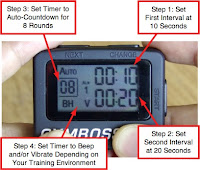In the last installment of "Interval Training Explained" we went over the "what" and "why" of interval training. This installment will focus on the "how?"
So what do you do?
First, interval training is stressful for the body (again, a GOOD thing in the right amount) so it should only be done 1 to 3 times per week for most people. The rest of your cardio, if you so choose to do it, should be steady pace also known as "steady state." This would be the jogging, any cardio exercise at a steady pace.
Mode
Before getting into too much, you need to choose an exercise "mode." A mode is simply that actual exercise movement you perform. Some examples are running, biking, push ups, planks, swimming, you name it.
The first consideration in selecting your mode is simplicity. You don't want to have to think too much about what you are doing. You'll have plenty to focus on with the intensity of interval training. Good examples are sprinting (NOT on a treadmill - DANGEROUS!!!!), swimming, biking, and various bodyweight exercises. A caution when swimming, do intervals in shallow water because you will get very tired and you don't want to have to tread water.
 |
| Sled pushing, don't be intimidated |
The next consideration is self-limitation. You want exercises that don't involve too much form break down. When you do interval training, your muscles get tired, when your muscles get tired your form can easily breakdown increasing the risk of injury. So you wouldn't select an olympic snatch, one of the most technical lifts in weightlifting. A better example would be up hill walking or running/sprinting, sled pushing, battling ropes, any "self-limiting" exercise.
 |
| The Olympic Weightlifting Snatch |
Work-to-Rest Ratio
Now that you have your mode selected it's time to plan the rest of the workout. With interval training there is a work-to-rest ratio. The work interval could be anywhere from 10 seconds to 3 or 4 minutes. Just keep in mind the shorter the burst, the harder the effort must be. After the burst you ease back to a steady pace until you catch your breath and are ready for another burst.
There are different levels of interval training. If you are just starting out, you can use a work:rest ratio of about 1:3 or 1:4. This means if your burst is 1 minute then you go back to a steady pace for 3 or 4 minutes. By the end of the burst you should be winded to the point that you can only speak a few words before you have to breath again. By the end of the rest period you should feel very recovered and ready for another burst.
For the more advanced, the work:rest ratio can be more around 1:2, 1:1, or even Tabata 20 seconds on and 10 seconds off for the very advanced.
Helpful Tools
Interval timers are a great tool to help. You can set the work interval time and the rest interval time. Many interval timers also allow you to set the number of rounds you want to perform. Once you get everything set, hit start and start working, when it beeps, rest, when it beeps again, start going again. Easy peasy.
Summary
As you can see interval training is a kick in the butt! However, it's great when you're short on time or want a little bit faster results. Just select your mode, choose your time intervals, set an interval timer and go!
*Make sure you warm up properly and listen to your body! If it says "stop" then "stop!"
If you like Fitness by Chris Finley please subscribe and spread the word! God bless! :)



No comments:
Post a Comment